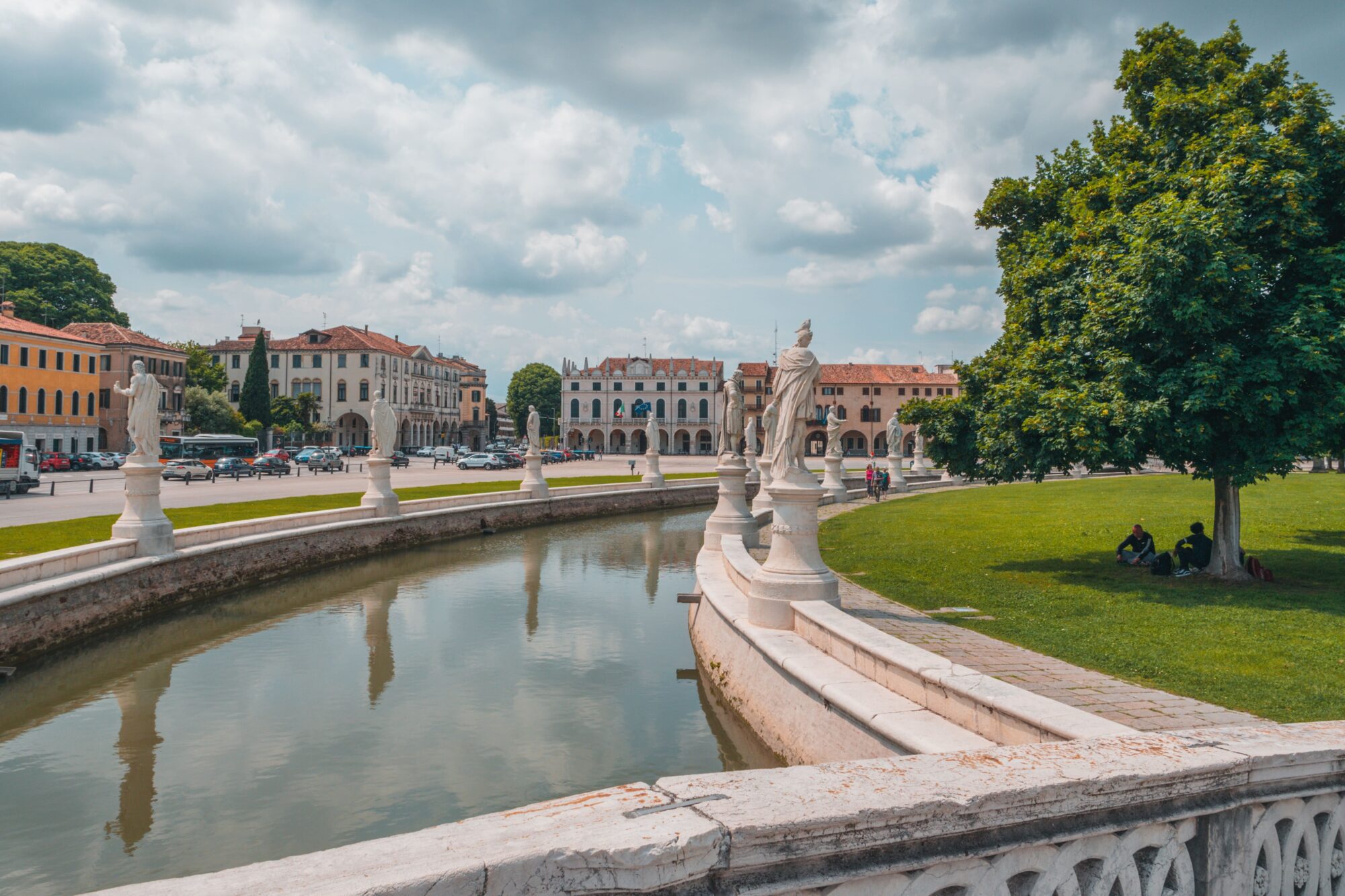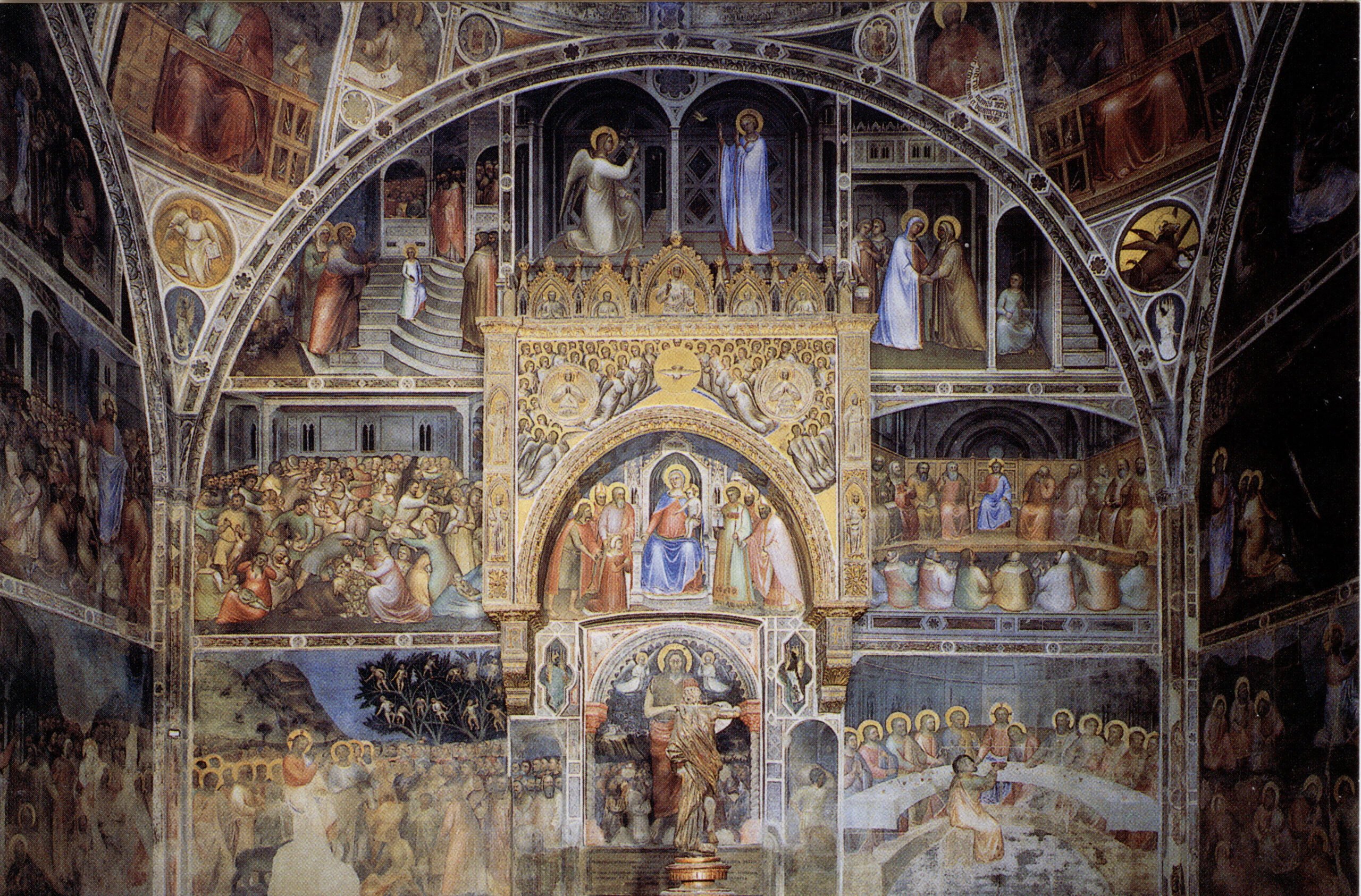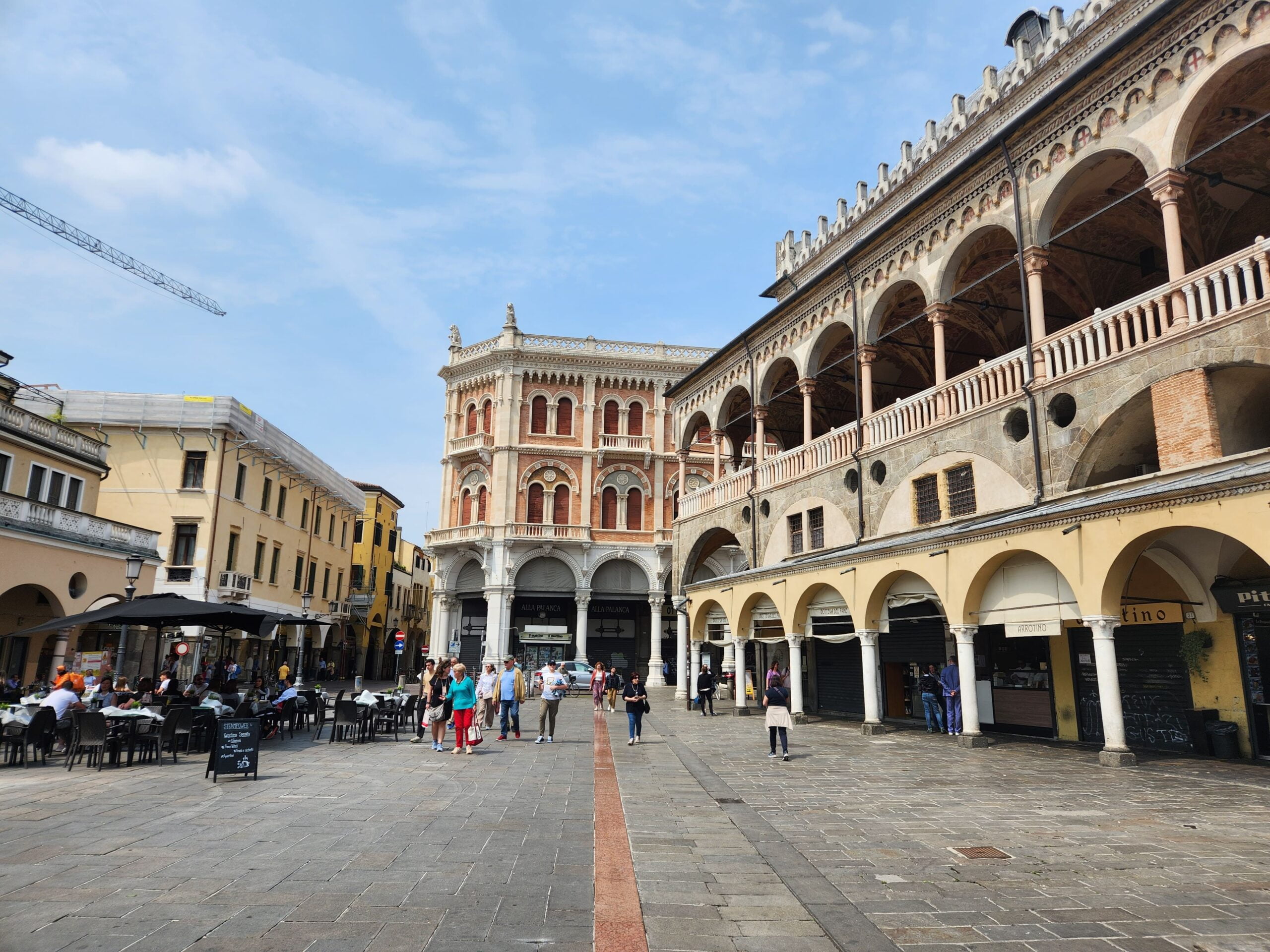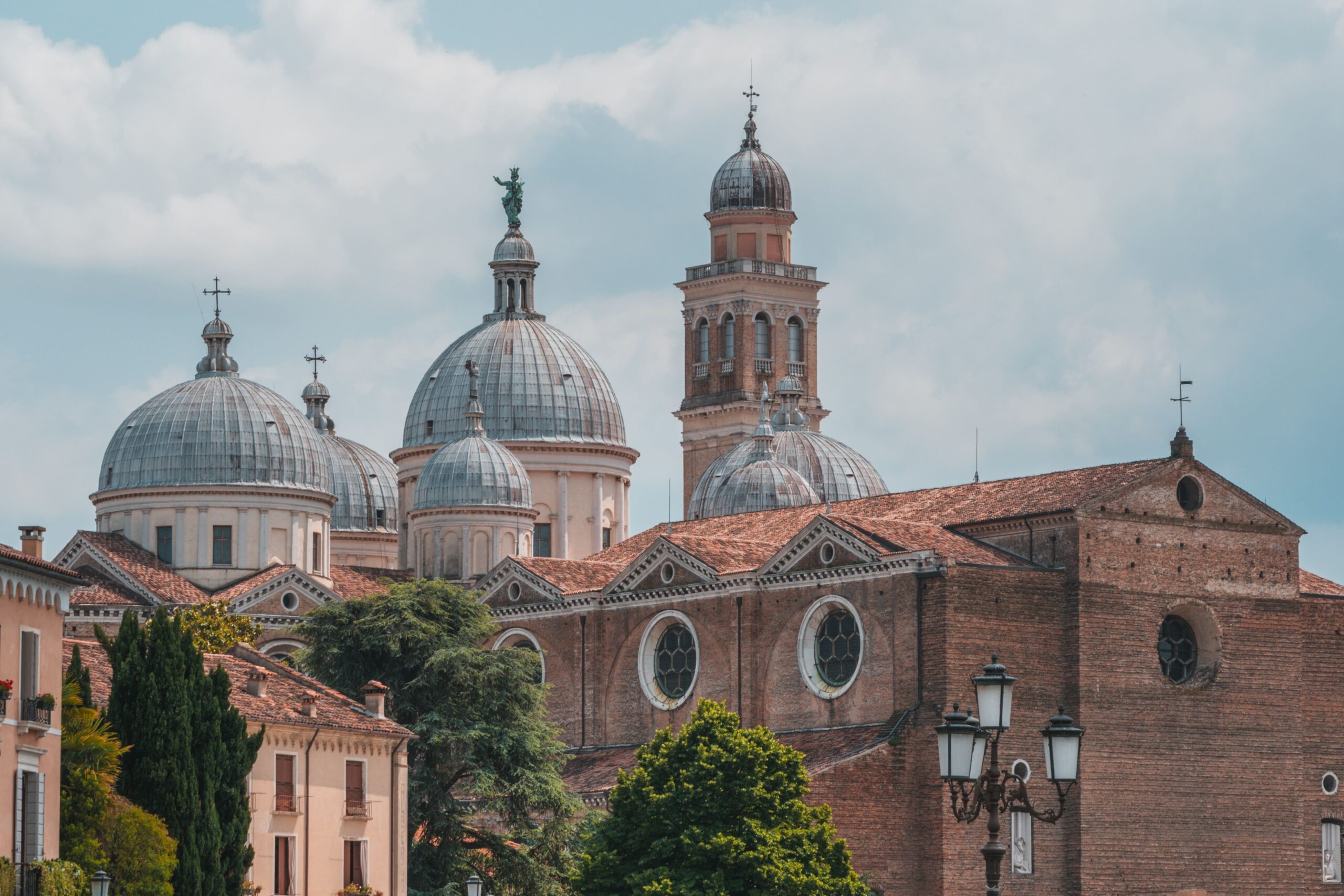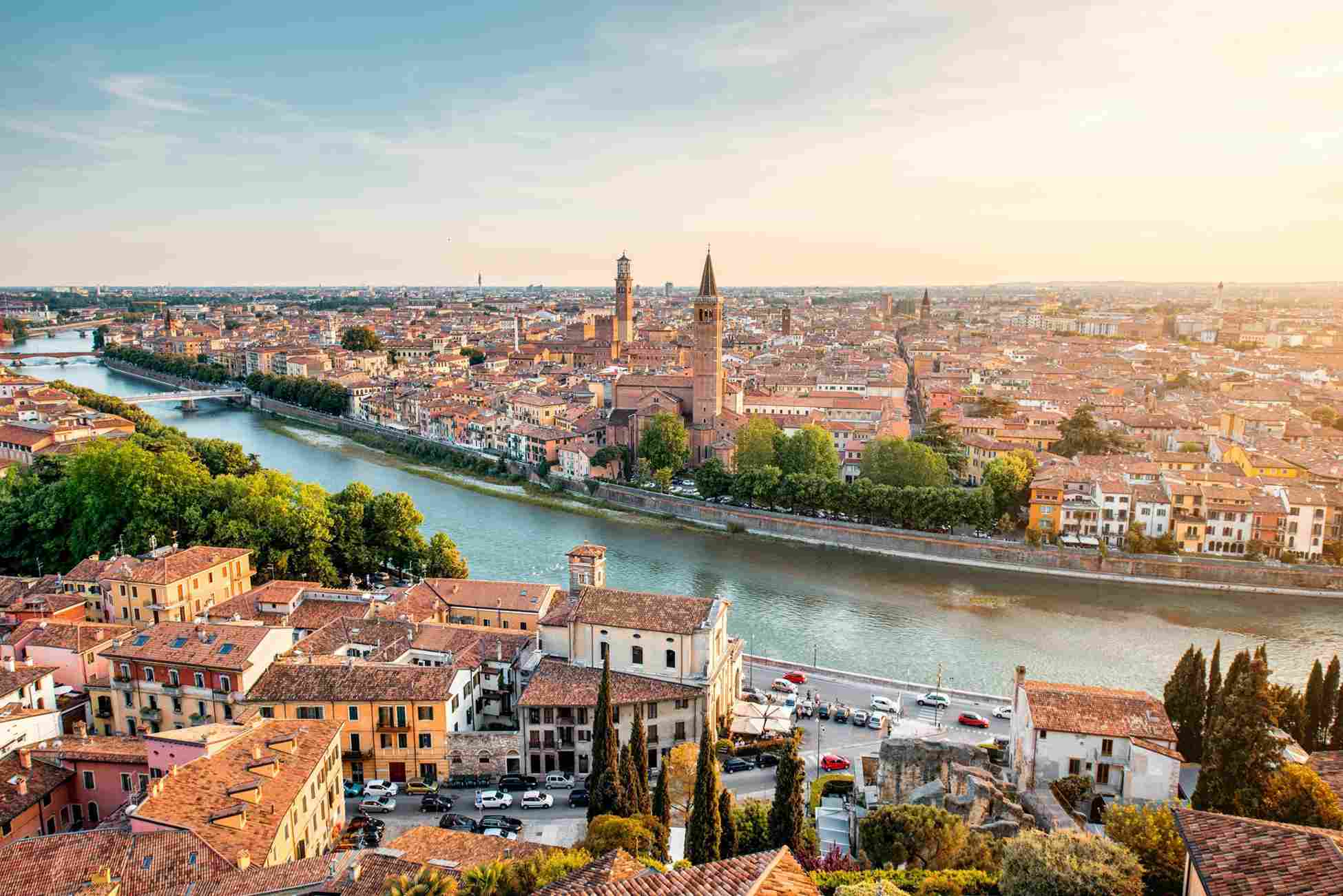Padua has been the scientific and educational center of the Veneto region for centuries, with Galileo Galilei as one of its professors and Nicolaus Copernicus as one of its students.
Padua is the first town where you begin to feel a significant change in architecture and urban design while traveling from Bologna along the Adriatic coast up to the north of Italy. With its beautiful blend of Romanesque, Gothic, Renaissance, and Baroque styles, the streets become wider, and the squares more spacious.
If you have a fondness for art and architecture, Padua is definitely a town to visit and perhaps even stay overnight on your way to Venice.
What to do in Padua in one day:
1. Morning Coffee at Eroica Caffe Padova
Quick Facts
Padua is an ancient city, with the first settlements dating back to around 1183 BC. It was under the rule of the Venetian Republic until the end of the 18th century. Then, for a brief period, it was a part of the Napoleon’s empire. After that, it was ruled by the Austrian Empire for a period and finally taken back by the Kingdom of Italy in 1866, remaining a part of Italy to this day.
Padova appears on the UNESCO World Heritage list three times:
- for the most ancient Botanical Garden in the world, dating back to 1545;
- for the frescoes of the Scrovegni Chapel, painted by Giotto at the beginning of the 1300s;
- for the 14th-century frescoes in the Ragione Palace.
The University of Padua is one of the oldest universities in the world, where Galileo Galilei taught and Nicolaus Copernicus studied.
Itinerary
Here’s our itinerary, guys, which essentially covers the main attractions of the town. The historical city center of Padua isn’t extensive, and all the highlights can be explored in a day, although it could be quite intense if you intend to leave the town on the same day.
We would suggest reserving accommodation for one night and taking a break before continuing your journey. This is particularly advisable if your next stop is Venice.
1. Morning Coffee at Eroica Caffe Padova
We arrived in Padua from Bologna early in the morning, and I happen to be the type of person who enjoys having two breakfasts in Italy. The typical Italian breakfast, consisting of a coffee (an espresso) or a cappuccino and a cornetto (croissant), doesn’t quite suffice for me. While I usually begin my day with a hearty American or English breakfast at home, during my travels, I like to embrace the Italian way for my second breakfast.
Alright, let’s be honest – I’m not exactly an early morning enthusiast. On the day of travel, I often find myself skipping a proper breakfast and settling for just a cup of coffee at best just to stay in bed a bit longer. Then, I rush to the railway station, sweating and swearing, all to catch the train seconds before it departs. Despite the common delays of trains in Italy, I still recommend arriving at the station on time, as some of them are punctual.
That’s why, whenever I’m traveling around Italy, I like to structure my itineraries to include my first stop at a coffee shop. This helps replenish my caffeine levels after spending a few hours on the morning train.
And folks, here’s a tip: try to avoid coffee shops near the railway station. The prices tend to be higher, and more importantly, the quality often leaves much to be desired.
We stumbled upon this charming place, conveniently a 19-minute walk from the station, which turned out to be the perfect spot for breakfast.
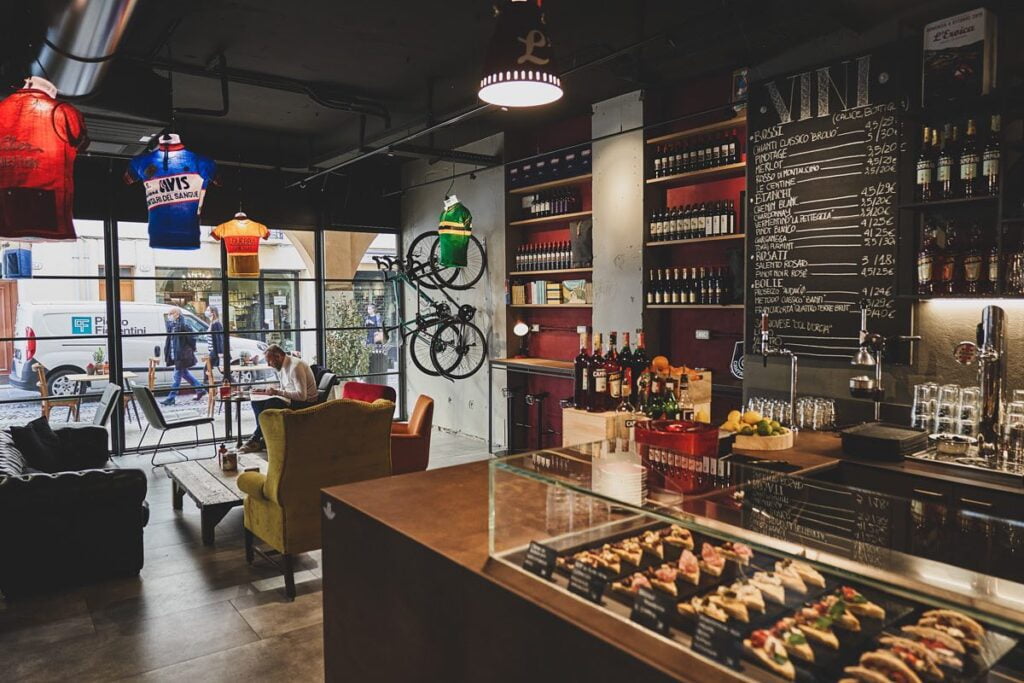
Besides breakfast, the folks at this espresso bar offer proper meals and a lunch menu. You can even enjoy an aperitif here. The place opens at 9 AM on weekdays and at 8 AM on Sundays. Just a heads up, it’s closed on Mondays.
After indulging in our second (or for some, first) breakfast the traditional Italian way: cappuccino + cornetto (croissant)*, we headed to our first destination: Piazza dei Signori, which is just a minute away from the café.
*By the way: Italians don’t call croissants a croissant, which is considered to be available only in France. They call it a cornetto (which is a proper Italian word) or a brioche (and this is French). Don’t ask me why.
2. Clock Tower in Piazza dei Signori
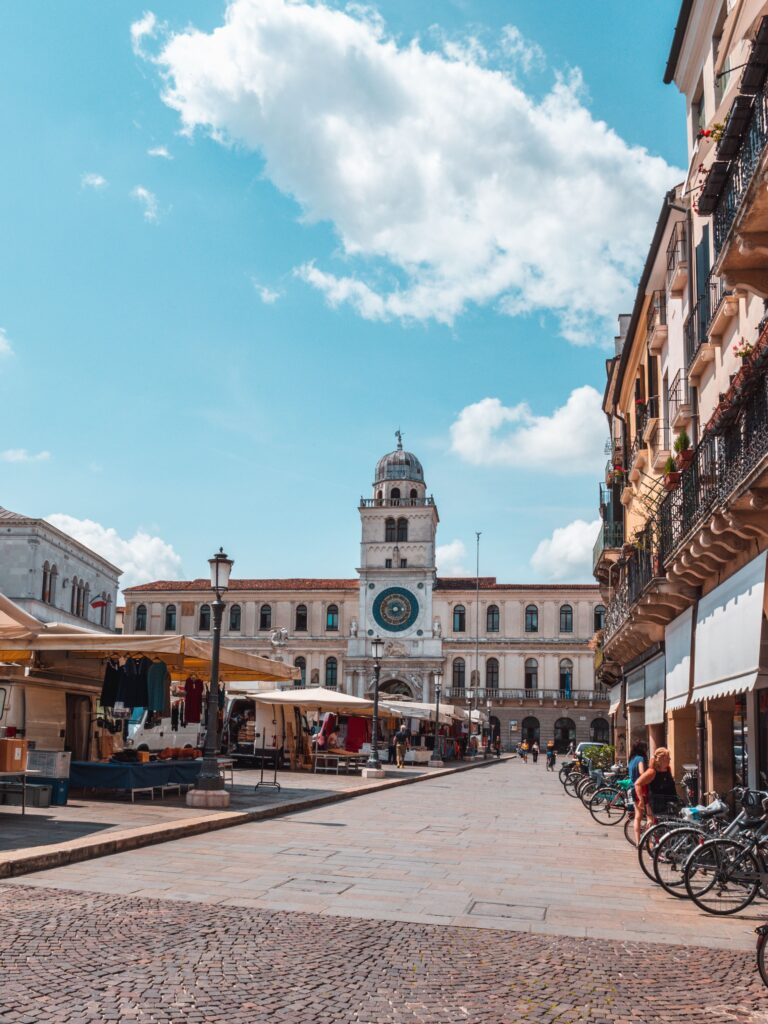
Upon entering the square Piazza dei Signori, the first thing you’ll notice is the famous and magnificent Torre dell’Orologio, also known as the Clock Tower.
The square itself isn’t very large, but it’s lively and dotted with cozy bars and restaurants. A clothing and accessories market sets up here in the first half of the day from Tuesday to Friday, as well as all day on Sundays.
Piazza dei Signori is one of the many squares that characterize the historic center of Padua. For centuries, it served as the backdrop for civic celebrations, tournaments, and was a representative space for the city.
The square was established in the fourteenth century through the demolition of an ancient neighborhood that used to stretch in front of the churchyard of San Clemente. Its unique shape made it a natural venue for tournaments.
The Clock Tower is a medieval building that looms over the Piazza. It stands between the Palazzo del Capitanio and the Palazzo dei Camerlenghi.
Built in the first half of the 14th century, the Tower originally served as the eastern gate of the Reggia Carrara, a complex of buildings owned by the Carraresi family, the rulers of Padua. Later, it was expanded and embellished in the Gothic style and adorned with the famous astronomical clock. This clock is the oldest surviving machine of its kind and, with a diameter of 5.6 meters, one of the largest as well.
Interestingly, the astronomical clock’s depictions of the Zodiac omit the sign of Libra. This absence stems from the fact that the depicted signs refer to the pre-Roman zodiacal system, where the constellations of Scorpio and Libra were combined.
Passing through the arch under the Torre dell’Orologio leads to Piazza Capitaniato. There, if you’re fortunate, you might come across a small crafts market featuring paintings, sculptures, photographs, and other handmade crafts. This market operates only on the first Sunday of each month, from March to June and from September to December.
From there, we made our way directly to the Cathedral Square, also known as Piazza Duomo.
3. Padua Cathedral
Italian: Duomo di Padova; Basilica Cattedrale di Santa Maria Assunta
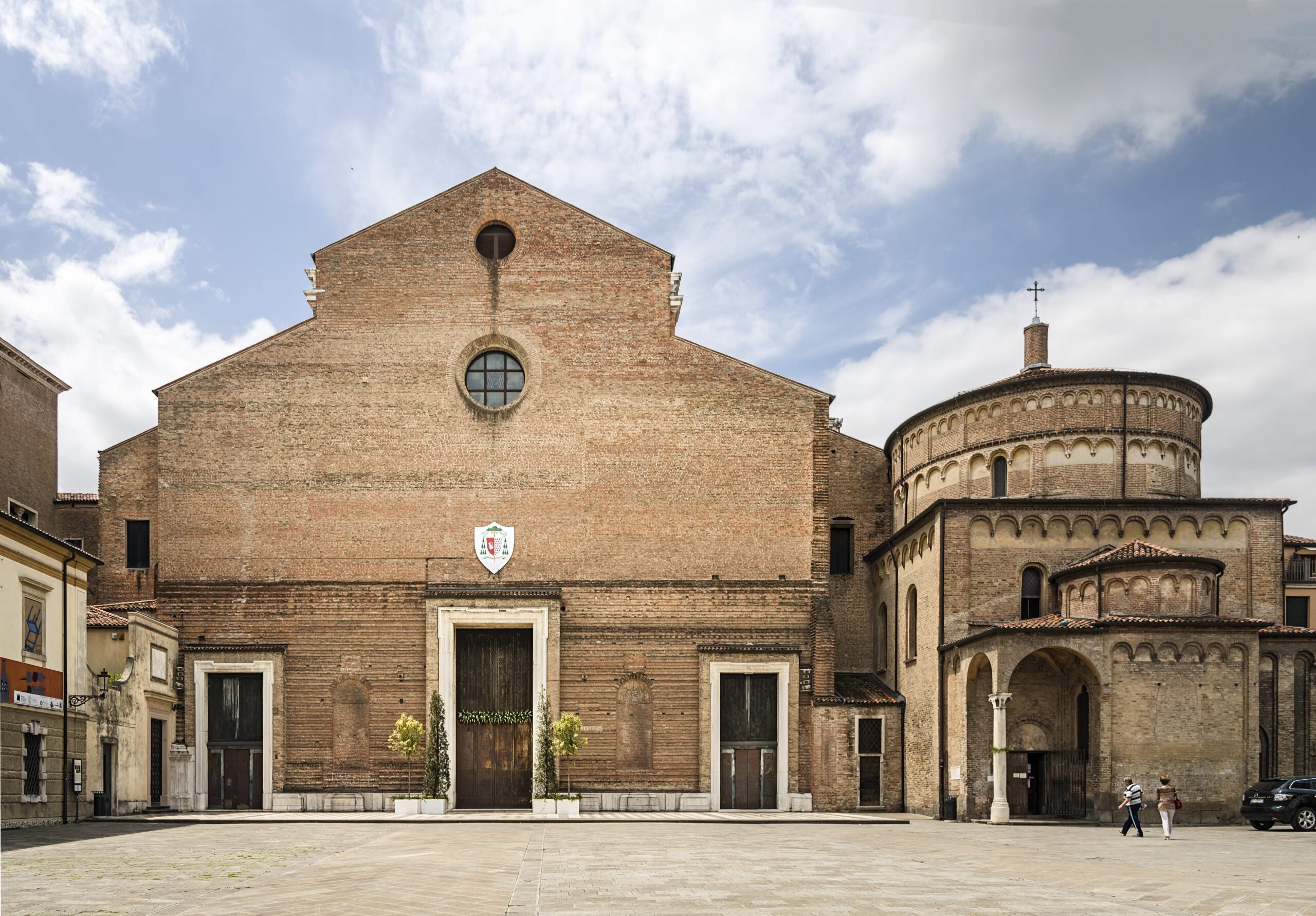
On the square, you’ll come across the facade of the Cathedral, which follows a fairly standard design similar to many other Duomos in this particular region and era, along with the Baptistery of St. Giovanni Battista. Now, I’m neither an architect nor an art expert to pass judgment on the design. Better see it with your own eyes.
Dedicated to the Assumption of the Virgin Mary, the cathedral serves as the seat of the Bishop of Padua. Originally built as a cathedral in the 4th century, the church has undergone significant reconstructions throughout its history.
The present-day church is the third structure to stand on this site. The initial cathedral was constructed after the Edict of Milan in 313, only to be destroyed by an earthquake on January 3, 1117. It was subsequently rebuilt in the Romanesque style.
The current building dates from the sixteenth-century reconstruction. While Michelangelo was initially attributed as the designer, the work was actually carried out by Andrea della Valle and Agostino Righetto. The design shares many similarities with earlier churches in Padua. Construction on this new Renaissance building commenced in 1551, spanning two centuries before finally being completed in 1754, albeit with an unfinished facade.
As for the interior, it tends to be rather minimalistic.
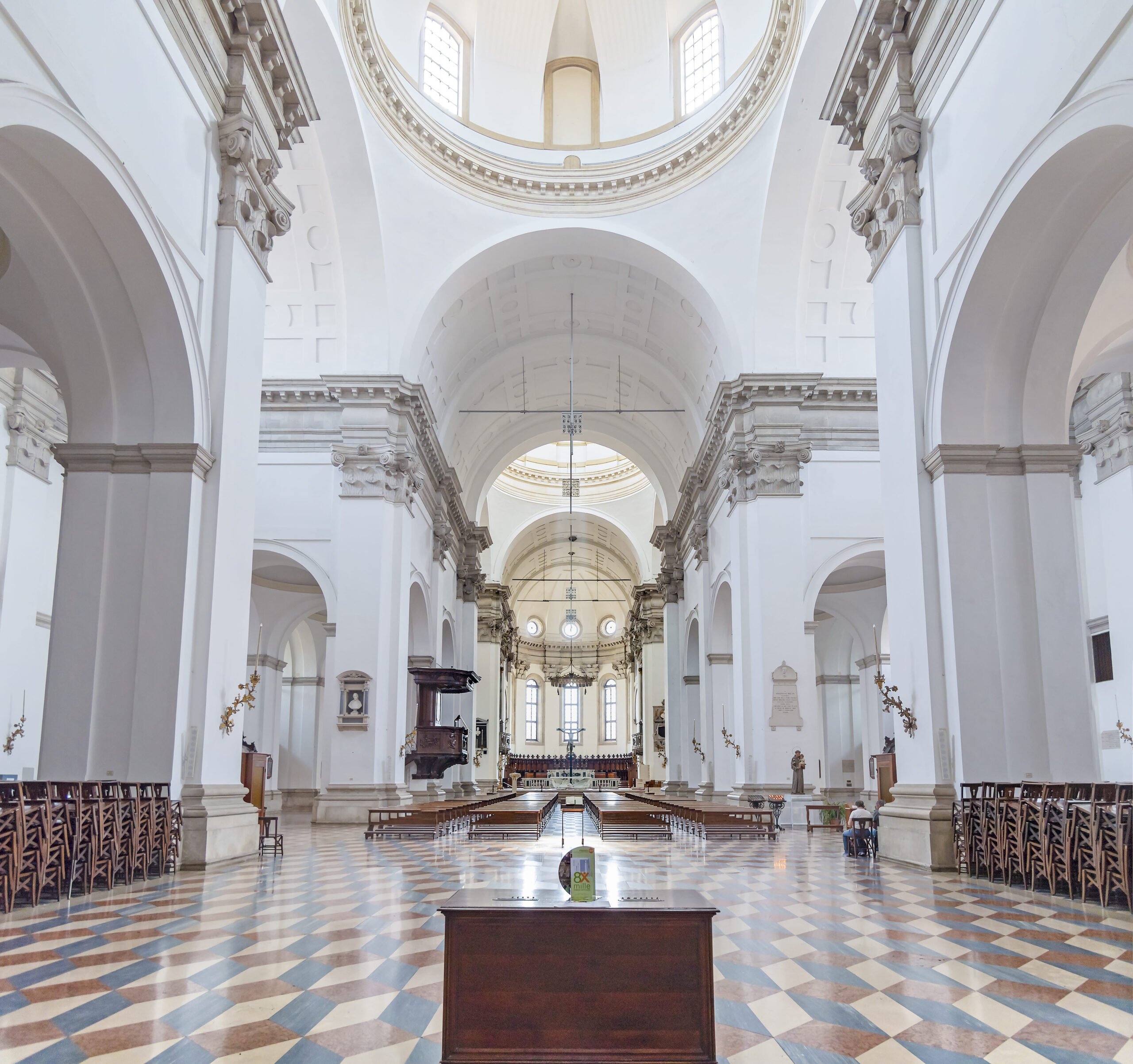
Entrance: free, 7:30 AM – 7:30 PM
The Padua Baptistery, dedicated to St. John the Baptist, is a religious building located adjacent to the cathedral in Padua. Its interior is renowned for housing significant 14th-century frescoes, a masterpiece by Giusto de Menabuoi.
While we didn’t venture inside the Baptistery, those interested in exploring medieval religious art can do so by purchasing an entrance ticket for 12 €.
Opening Hours:
Mondays 14.00/14.30/15.00/15.30/16.00/16.30/17.00/17.30.
Tuesday, Wednesday, Thursday: 10.30/11.00/11.30/12.00/12.30/13.00/14.00/14.30/15.00/15.30/16.00/16.30/17.00/17.30.
Friday, Saturday, Sunday and public holidays: 10.30/11.00/12.00/12.30/13.00/14.00/14.30/15.00/16.00/16.30/17.00/17.30
It is recommended to buy the tickets in advance here or making a reservation by calling +39 0174 330976 or sending an email to booking@kalata.it
Ticket Price: 12 €
The Palazzo della Ragione served as a medieval market hall, town hall, and palace of justice. The upper floor was historically dedicated to town and justice administration, while the ground floor continues to house the city’s historical covered market, considered to be the oldest covered market in Europe.
This palace divides the two market squares, Piazza delle Erbe and Piazza dei Frutti (which literally translates to “herbs square” and “fruits square”). It’s also known as “il Salone” (the Big Hall) and is recognized as a part of UNESCO World Heritage due to its 14th-century fresco cycles that adorn all four walls of the interior. The artistic work is divided into over three hundred distinct scenes.
Opening Hours: Tuesday – Sunday: 09:00-19:00. Closed days: every Monday (except holidays), 1st May, 25th and 26th December, 1st January. Last entry 30 minutes before closing hour
Ticket price: 8 €
Don’t miss the chance to explore the covered market. It exudes a unique atmosphere with passionate Italian vendors offering meat, cheese, olive oil, and of course, wine from the Veneto region as well as other parts of Italy.

Entrance: free, from 9 AM – 1 PM, 4 PM – 7:30 PM, closed on Sundays.
From here we proceeded to the Bo Palace.
6. Bo Palace
Italian: Palazzo Bo

And finally, we have reached the heart of the University of Padua.
The Bo Palace has served as the historical seat of the University of Padua since 1493. To this day, it houses the Rectorate and the School of Law. Additionally, Palazzo Bo is home to the world’s oldest anatomical theatre.
You can explore the courtyards of the Palace and view the displayed artworks, as well as the Anatomical Theatre. Several other sites can be visited during a guided tour, including the Galileo Galilei Great Hall (l’Aula Magna Galileo Galilei), the Hall of Forty (la Sala dei Quaranta), the Hall of Medicine (la Sala di Medicina), and the Hall of Law (Sala di Giurisprudenza). However, due to the Palace’s ongoing academic activities, not all halls may be accessible for visits during weekdays as they might be used for lectures.
While we didn’t take a guided tour due to our rush to explore most of Padua in a single day, we did enter the Palace’s courtyard. The courtyard’s perimeter walls are adorned with the coats of arms of various families whose members studied here and contributed to the University of Padua. It’s quite fascinating to observe crests from different countries and epochs.
If you decide to visit Palazzo Bo, it’s recommended to book a guided tour in advance. You can purchase your tickets here.
Opening Hours:
“Palazzo Bo – Giro storico” – from Monday to Friday
10.30 am (Italian) – 11.30 am (English) – 12.30 am (Italian) – 1.30 pm (English) – 3.30 pm (Italian) – 4.30 pm (English) – 5.30 pm (Italian).
“Palazzo Bo e il ‘900 di Gio Ponti” – Saturdays, Sundays, and observed holidays
9.30 am (Italian) – 10.30 am (Italian) – 11.30 am (English) – 12.30 pm (Italian) – 1.30 pm (English) – 2.30 pm (Italian) – 3.30 pm (Italian) – 4.30 pm (English) – 5.30 pm (Italian).
Ticket Price: 7 €
7. Ghetto of Padua
Italian: Ghetto di Padova
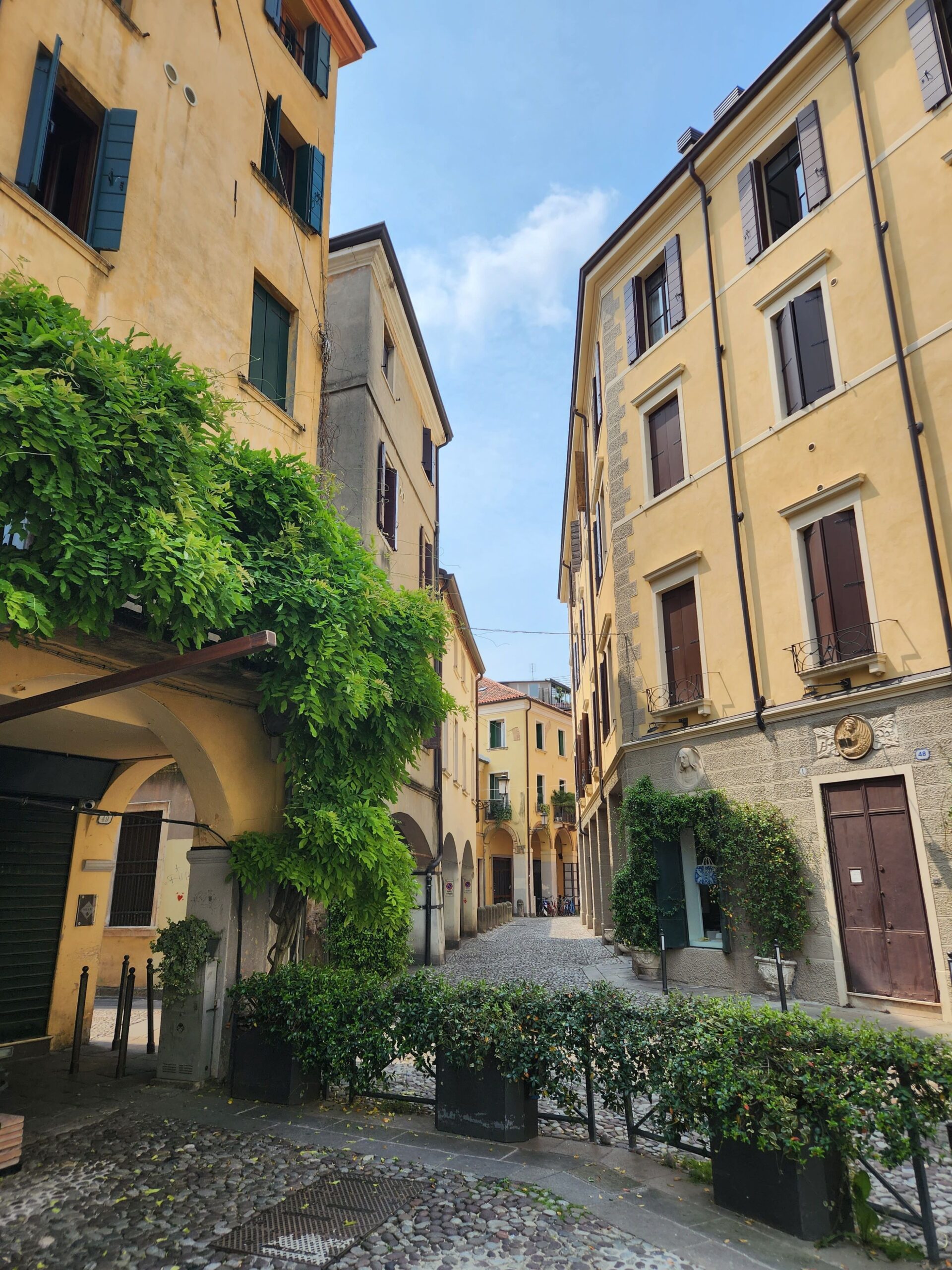
From the Bo Palace, we made our way to Prato della Valle, the largest square in Italy, passing through the Jewish Ghetto of Padua.
Today, the area is a charming neighborhood with craft workshops, stores, wine bars, and coffee shops. You can enjoy a leisurely stroll through its cozy streets or stop at a bar for an aperitif.
However, the term “Ghetto” carries a historical weight, as it signifies the dramatic history of Padua’s Jewish community. Like in many parts of Europe, they were segregated by the Venetian Republic from the rest of the city until the late 18th century. The arrival of Napoleon marked a turning point when the Jewish people were finally granted freedom and equality.
Within the neighborhood, there’s an old synagogue and the Jewish Museum of Padua, though our hunger prevented us from visiting.
Descending from the Ghetto to Prato della Valle, you’ll cross the Ponte delle Torricelle, offering a pleasant canal view. Although this spot may not hold anything particularly extraordinary, it remains a distinctive feature of Padua.
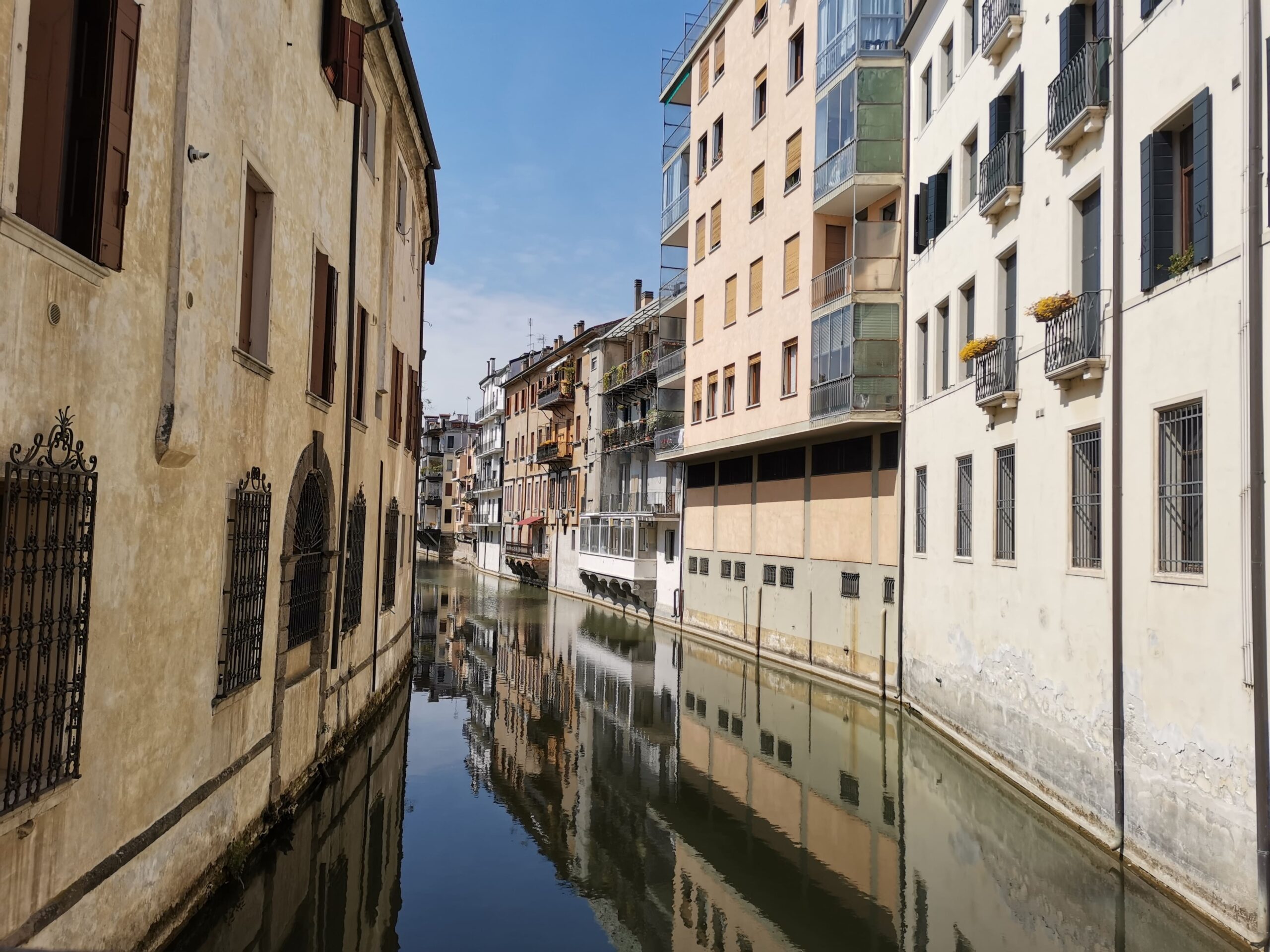
8. Prato della Valle (square)
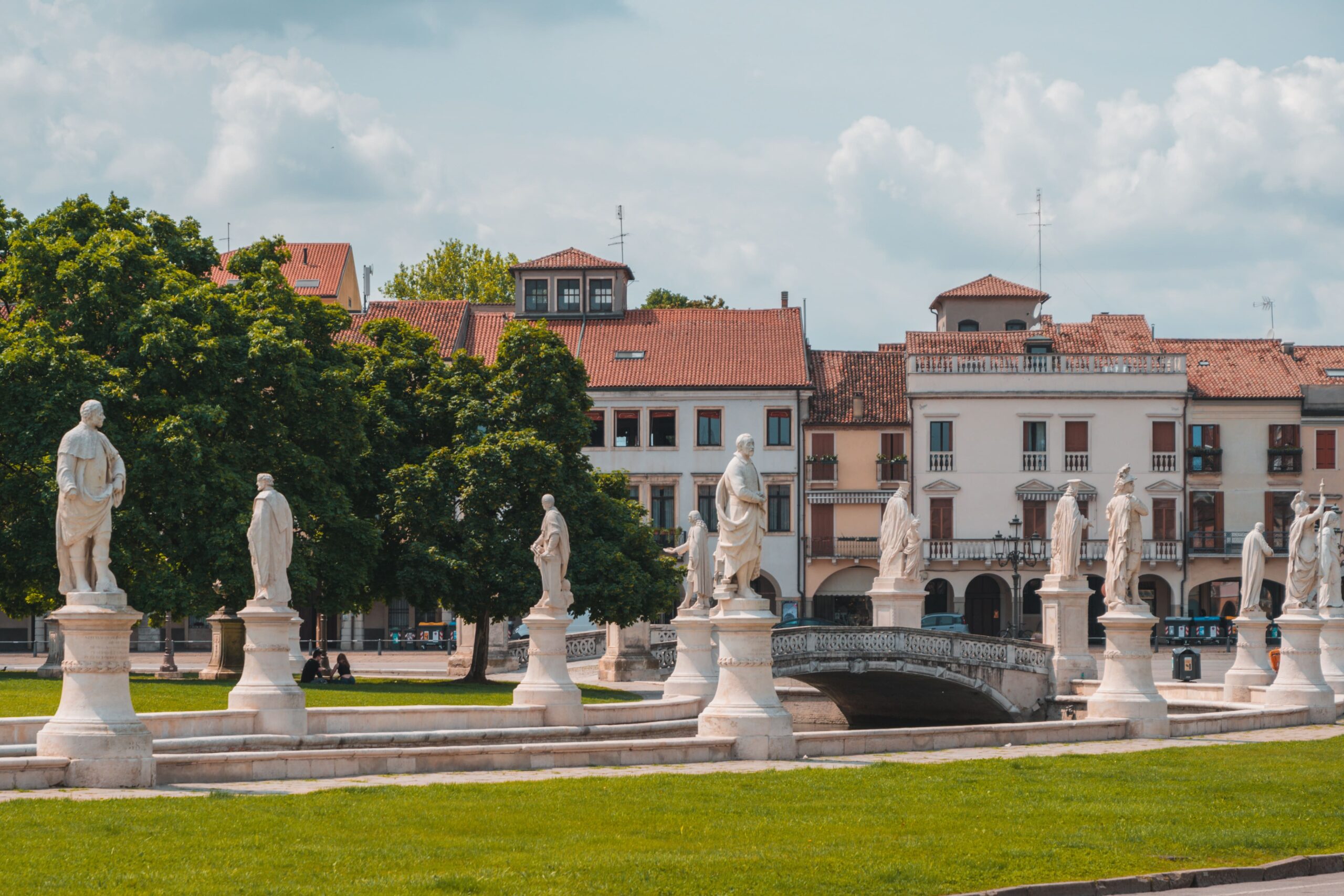
Just a 10-minute walk from the Ghetto and at the end of Via Umberto I, a vast and stunning square, Prato della Valle, unfolds before your eyes.
Prato della Valle is not only the largest square in Italy but also one of the largest in Europe. Today, the square features a spacious central green island, surrounded by a small canal bordered by two rings of statues.
A total of 78 statues encircle the oval-shaped square. Yes, you read that right – the square is actually oval, despite how unusual that might sound. These statues, created by various artists using Vicenza stone, were crafted between 1775 and 1883.
It’s a popular spot for locals to relax, read a book, or simply have a chat with friends under the shade of the trees on warm days. On Saturdays, a clothing market takes place here, and from Mondays to Fridays, you’ll find a fruits and vegetables market.
9. Lunch: Terrazza Carducci
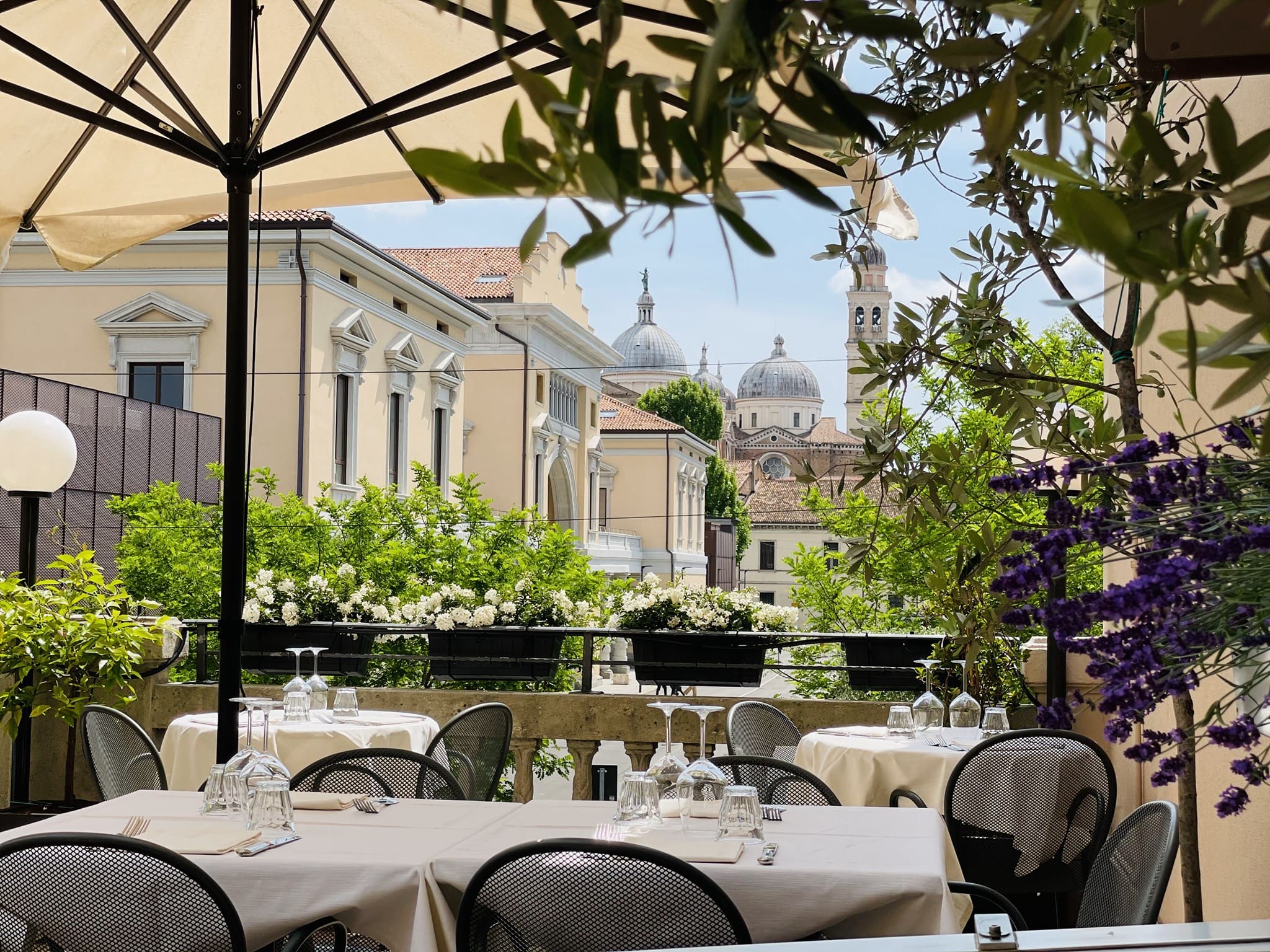
Yes, by this point, you’ll likely be tired and hungry – we certainly were! Plus, remember that lunch schedules in Italy are quite strict. Lunch is typically served during the “Italian schedule,” which is usually from 12:00 to 14:30. If you arrive later, you might find the kitchen closed. It’s important to reach the restaurant by 14:00 at the latest. And always, always make a reservation in advance. Otherwise, you might end up settling for fast food. But you didn’t come to Italy to eat junk food, did you? Plus, the price of a McDonald’s meal in Italy is higher than that of a delicious plate of pasta.
I’ve been to Terazza Carducci twice, and both times were fantastic. I chose this place for several reasons:
- It’s conveniently located on our route
- They serve outstanding local cuisine
- The restaurant boasts a terrace with a splendid view, partially overlooking Prato della Valle and Abbey of Santa Giustina
So, I highly recommend this restaurant, and the staff is remarkably friendly, which isn’t always common in Italian tourist cities.
Having concluded our fantastic lunch, accompanied by a tad too much wine and a final shot of grappa, we resumed our journey towards the Abbey of Santa Giustina, conveniently situated just across the square from Prato della Valle.
The Abbey is a complex of Benedictine buildings dating back to the 10th century, situated in front of Prato della Valle. Adjacent to the former monastery is the basilica church of Santa Giustina, initially erected in the 6th century but reconstructed in the 17th century, as it appears today.
The Basilica of Santa Giustina ranks as the seventh largest in Italy. This church is dedicated to St. Justina of Padua and to other Christian martyrs from the 4th century. It houses a collection of religious art and artifacts. Its sanctuary stands as one of the oldest structures in Veneto, dating back to the 6th century.
Entrance: free, 7:30 AM – 12 PM, 3 – 6 PM
11. Padua Botanical Garden
Italian: Orto Botanico di Padova
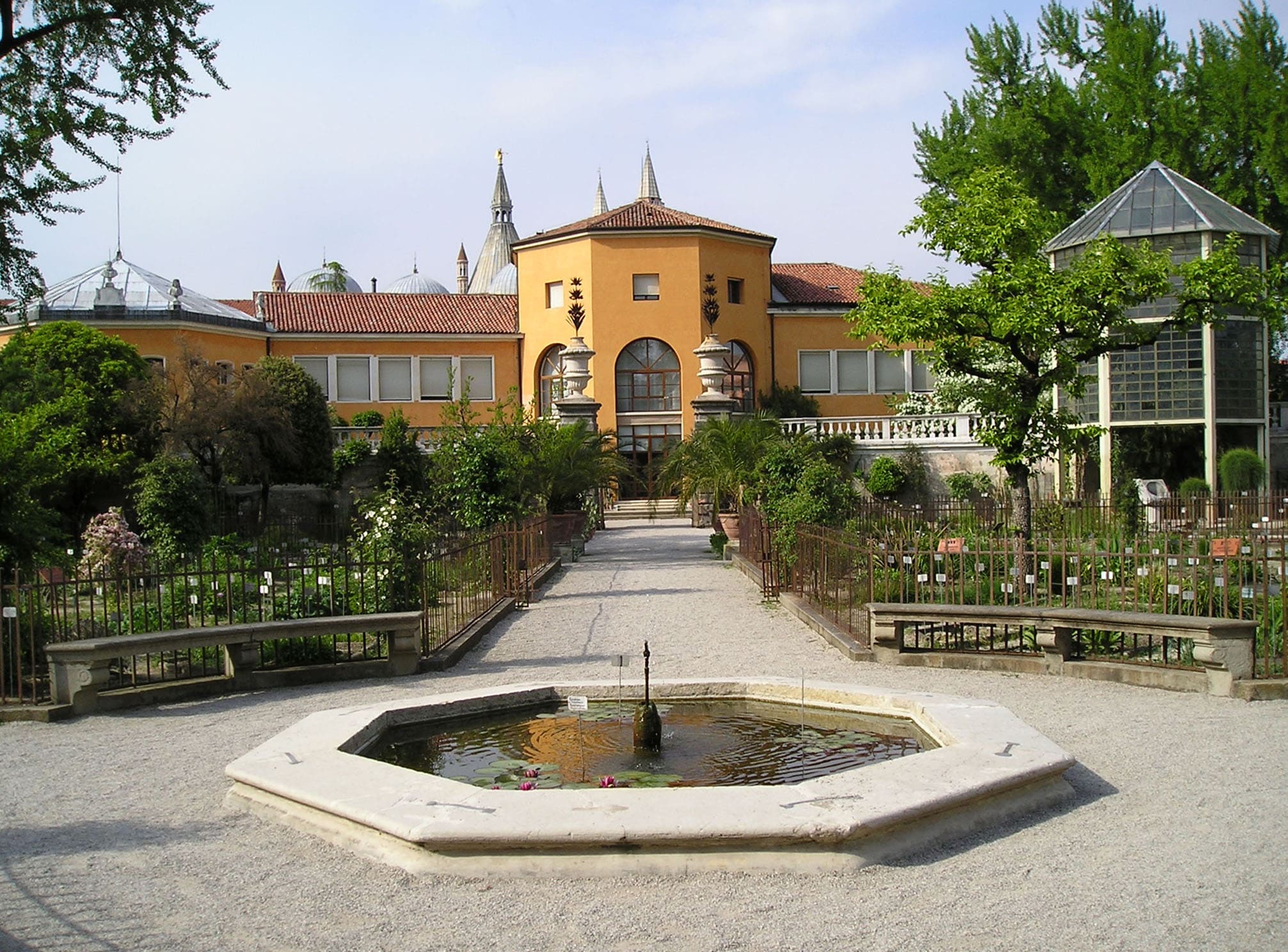
The Orto Botanico di Padova, established in 1545 by the Venetian Republic with a focus on cultivating medicinal plants, stands as the world’s oldest academic botanical garden. Still situated in its original location, the garden is overseen by the University of Padua. Its historical layout and distinctive collections make it a significant destination. With a collection exceeding 6,000 plants encompassing 3,500 species, it offers a rich exploration.
While its visit is certainly recommended, it’s important to allocate a minimum of 2 hours if you wish to fully appreciate it, and more time based on your pace.
Opening Hours:
- November – March: 10 AM – 5 PM (closed on working Mondays and from 9th January to 13th February 2023). Last entry: 4:15 PM
- April – September: 10 AM – 7 PM (closed on working Mondays except for Monday 12th June 2023). Last entry: 6:15 PM
- October: 10 AM – 6 PM. Last entry: 5:15 PM.
Ticket Price: 10 €
Upon receiving the advice from the Botanical Garden staff that a comprehensive exploration would require around 2 hours, we chose to postpone our visit until the following day. Our schedule required punctuality for our pre-booked guided tour of the Scrovegni Chapel. As a result, we continued to our next destination: the Basilica of St. Anthony, which marked our penultimate stop prior to the Scrovegni Chapel.
12. Basilica of St. Anthony
Italian: Basilica Pontificia di Sant'Antonio di Padova
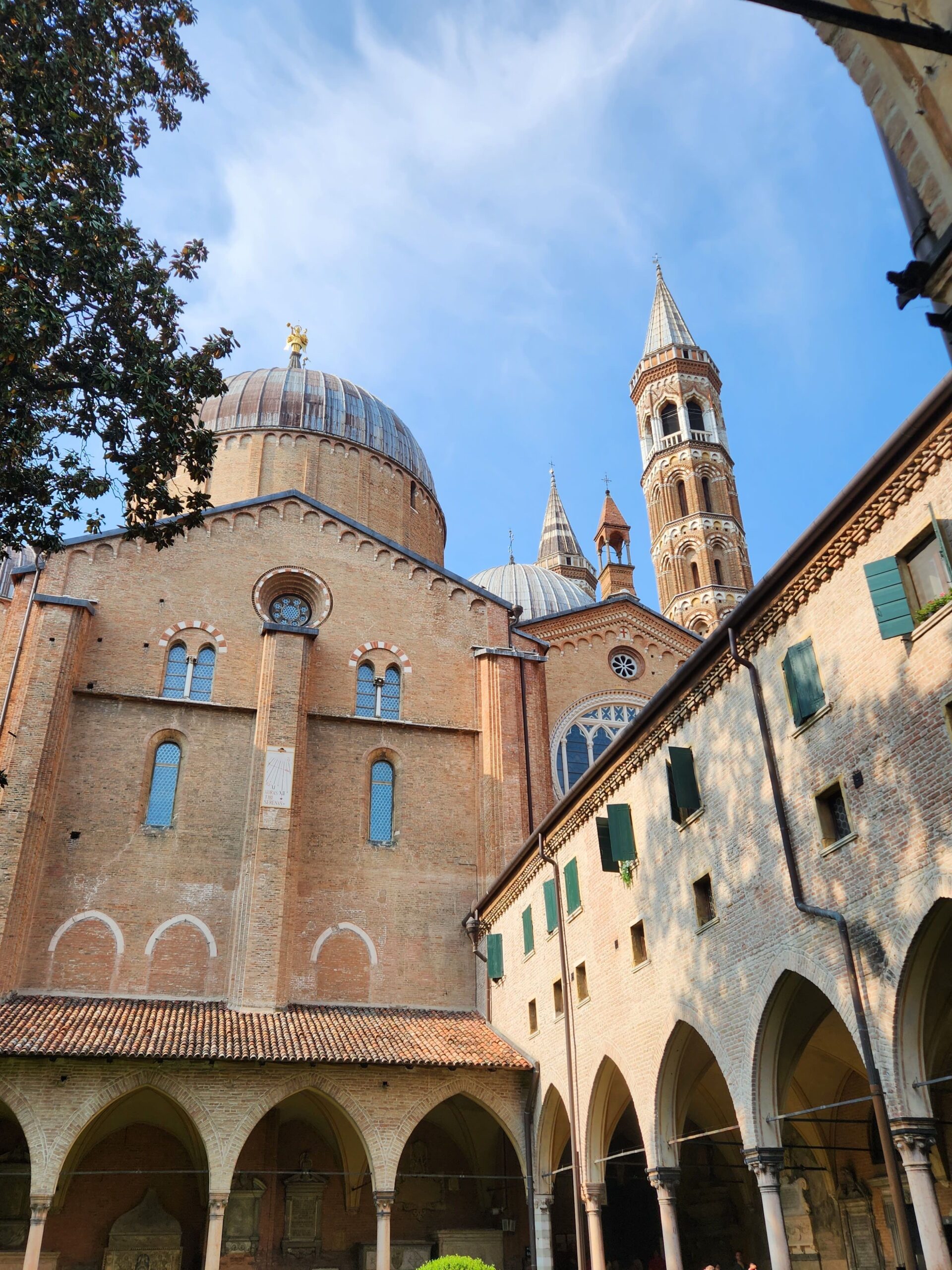
The Pontifical Basilica of Saint Anthony of Padua is a Catholic church and minor basilica located in Padua, dedicated to St. Anthony, the patron saint of the city.
Architecturally, the Basilica stands as a grand structure that defies precise classification due to its evolutionary growth influenced by various styles over time, evident in its exterior detailing.
The Basilica’s construction commenced in approximately 1232, merely a year after the passing of St. Anthony, and was finalized in 1310. However, several structural alterations were made between the late 14th and mid-15th centuries.
Inside the church, one encounters a multitude of funerary monuments, some of which hold significant artistic value. Notably, among them is the tomb of St. Anthony himself.
The Basilica attracts pilgrims worldwide who seek to pray at the relics of St. Anthony. Renowned for his compelling preaching, scriptural knowledge, and commitment to the underprivileged and ailing, St. Anthony achieved swift canonization, less than a year following his demise.
He is particularly venerated as the patron saint for locating lost objects and is credited with numerous miracles linked to finding both people and possessions.
Despite the Basilica’s captivating interior, we didn’t linger extensively. Fatigue from the day’s explorations and the bustling crowd of tourists might have played a part in our brief stay.
Entrance: free, 6:15 AM – 7:30 PM
With the Basilica of St. Anthony behind us, we proceeded to our final destination of the day: the Scrovegni Chapel.
13. Scrovegni Chapel
Italian: Cappella degli Scrovegni
We arrived at the Chapel without any hurry. However, a sudden realization struck us – we were running late, and our tour group had already entered the Chapel. The timing is quite stringent at this location, despite the perception of a leisurely Italian pace, especially in the more northern parts of Italy.
Fortunately, the staff kindly accommodated us, allowing us to catch up with the 17:30 group in the glass pavilion. The tour commenced with an informative film about the Chapel.
Following the documentary, we were finally granted access to the Chapel itself. This petite church is adorned with frescoes by Giotto, covering the walls and ceiling. Indeed, the Scrovegni Chapel is renowned for this very reason. Inside, you are allotted a mere 15 minutes. Consequently, the entire visit to the Chapel spans about 30 minutes.
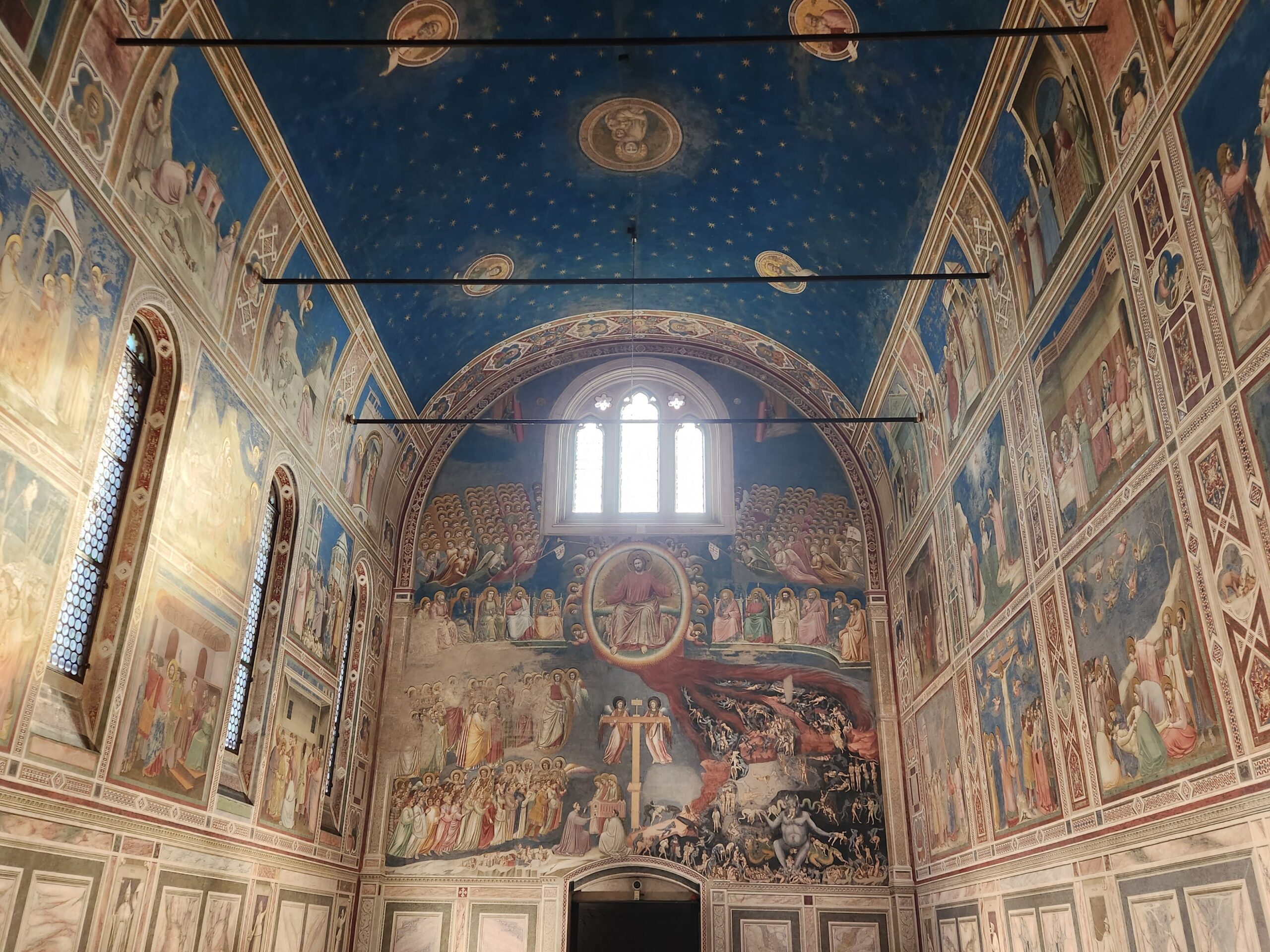
The fresco cycle by Giotto, completed around 1305, stands as a significant masterpiece of Western art. In 2021, the chapel was rightfully included in the UNESCO World Heritage Site list. The Scrovegni Chapel houses pivotal frescoes that heralded a revolution in mural painting, shaping fresco technique, style, and content for an entire century.
What made Giotto’s style revolutionary? Unlike his contemporaries, who adhered to the Byzantine style characterized by two-dimensional figures and stylized imagery that veered away from naturalistic depictions, Giotto embraced a resolutely three-dimensional approach. He meticulously portrayed his figures with intricate facial expressions and gestures drawn from close observation. The figures he depicted were attired not in the swirling, formalized drapery typical of Byzantine art, but in garments that hung naturally, imbued with form and weight.
While I may not consider myself a devout connoisseur of art, especially religious art, the Scrovegni Chapel stands as one of Padua’s most paramount artistic landmarks. Giotto’s art played an indispensable and influential role in the art of his era.
In my view, a visit to the Scrovegni Chapel is an absolute necessity during a stay in Padua. However, it’s essential to book your tour in advance and ensure punctuality!
Opening Hours: everyday from 9 am to 7 pm.
Ticket Price: 16 €
With the Chapel being our final destination for the day, we proceeded to the adjacent Giardini dell’Arena park for an aperitif.
Throughout the spring and summer seasons, the park boasts an open bar and street food stalls. Thus, we procured our Aperol and Campari Spritz (there 2 types of people as usual;) and nestled onto the grass to savor our drinks and unwind after a lengthy day.
Transport and Moving Around
You can conveniently access Padua by train:
- From Bologna: Approximately 1 hour
- From Verona: 45 minutes to 1 hour
- From Milan: About 2 hours
- From Venice: Around 30 minutes
If you prefer to explore using a rented car, we would advise you to park it within the town and continue on foot.
During our visit, we covered the town on foot, and we recommend this approach. Yes, it involved a considerable amount of walking, but all the major attractions in Padua are within close proximity, enabling you to truly experience the town’s ambiance and appreciate its splendor. Moreover, securing a parking spot can pose quite a challenge in Italian towns.
Tips
Padua is 30-min away from Venice by train, thus it is convenient and much cheaper to book a hotel here and stay in Padua overnight before visiting Venice.
Summary
This itinerary is feasible to complete within a single day, but honestly, it will be quite intense. In our case, we opted not to visit Padua Baptistery and skipped the guided tour inside the Bo Palace, only exploring its courtyard. We also chose to postpone the visit to the Botanical Garden as it requires a minimum of 2 hours, and we already had tickets booked for the Scrovegni Chapel at 17:30.
At our pace, completing this itinerary took us approximately 8 hours.
If you’re aiming to cover all the highlights in Padua, we strongly recommend booking a hotel room and staying overnight. This way, you can explore the Botanical Garden and perhaps save attractions like the Scrovegni Chapel for the next day. Taking this approach will allow for a more leisurely stroll through the town, giving you the chance to enjoy a gelato along the way or take breaks for relaxing aperitif moments.
Wishing you a fantastic time in Padua, and please do share your thoughts on our itinerary and the attractions that left a lasting impression on you!
Seeking a day trip from Padua?
With just a 1 hour journey, you can discover the legendary city of love.
Check our travel guide to Verona!
Verona is a city in northern Italy that wears the badge of love proudly, thanks to Shakespeare’s timeless duo, Romeo and Juliet, who happened to call this place home. However, I dare to say that Romeo and Juliet are
